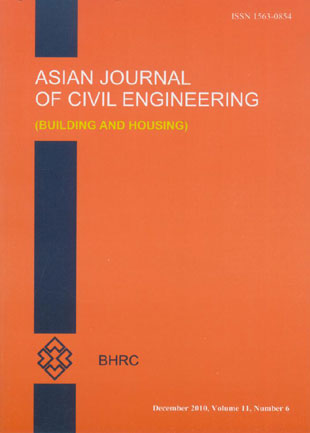فهرست مطالب

Asian journal of civil engineering
Volume:11 Issue: 6, Dec 2010
- special issue on optimization
- تاریخ انتشار: 1389/05/23
- تعداد عناوین: 7
-
-
Page 675Imperialist Competitive Algorithm (ICA) is one of the recent meta-heuristic algorithmsproposed to solve optimization problems. The Imperialist Competitive Algorithm is basedon a socio-politically inspired optimization strategy. This paper presents four differentvariants of this algorithm. These methods are applied to some engineering design problems and a comparison is made among the results of these algorithms and other meta-heuristics. The results show the efficiency and capabilities of the ICA in finding the optimum design.
-
Page 699Bridges with composite steel box girders are used at the intersection of many modernbridges. Heuristic optimization methods are the new techniques developed in the last twodecades that employ stochastic approaches. This paper deals with the size, shape andtopology optimization of composite steel box girders using Particle Swarm Optimization(PSO) method. The advantage of using PSO compared to gradient based techniques lies in the fact that the discrete spaces can be optimized in a simple manner. This algorithm was written in Python language in the finite element analysis software, ABAQUS, environment as a script file. The objective function is the minimization of total weight of the structure under strength and serviceability constraints, enforced by penalty functions. All design requirements correspond to the American Association of State Highway and Transportation Officials (AASHTO) and Iranian Codes of Practice (ICP) for Loading of Bridges Compared to a conventional feasible design, the optimum solution showed a 55% reduction of structural weight.
-
Page 717We present a new strategy for applying to continuous genetic algorithm for damagedetection of structures. This strategy pursues twoAims1) reducing search space byelimination of some design variables during optimization process, 2) improving eachindividual by solving the linearized problem using Moore-Penrose pseudo inverse at the endof reproduction of genetic algorithm. To these ends, two sub-programs are embedded after typical GA operators. This strategy is applied to three different types of problems: damage detection by frequencies and by static measurements, and crack identification of a beam using frequencies. Numerical results demonstrate the high efficiency of the proposed algorithm compared to those found in the literature.
-
Page 741Genetic Algorithms are best suited for unconstrained problems; however, most of thepractical cases have constraints. As a common approach, modifying initial population due toproblem-specific information has not yet come to an end. This is due to the generalizationchallenges and also the lack of diversity and effectiveness regarding relatively narrow sizeof the feasible subspace of the entire search space. In this article, a new type of expanding genetic population is presented starting from its minimal size. Suitable ideas from ant colony and simulated annealing approaches are utilized for an adaptive efficient search which is also tuneable by the developed extra control parameters. Effectiveness and efficiency of the proposed method are illustrated by capturing the global optimum in a number of well-known structural size and layout optimization examples in a considerably less fitness evaluations compared to the other standard methods.
-
Page 765This study presents applications of a simulated annealing integrated solution algorithm tothe optimum design of single-span steel truss bridges subjected to gravity loadings. In theoptimum design process of a bridge the members are sized simultaneously as the coordinates of the upper chord nodes are determined such that the least design weight is attained for the structure. The design constraints and limitations are imposed in accordance with serviceability and strength provisions of ASD-AISC (Allowable Stress Design Code of American Institute of Steel Institution) specification. A numerical example is presented, where ptimum designs produced according to nine alternative topological forms of single-span truss bridges, namely Pratt, Parker, Baltimore, Pettit, K-Truss, Warren, Subdivided Warren, Quadrangular Warren and Whipple are compared for a selected span length of 600 ft (182.88 m) to quantify the influence of choice of a topological form on the final design weight of the bridge.
-
Page 779In the present study, an efficient optimization algorithm is proposed to optimal design ofstructures. The proposed algorithm is an improved particle swarm optimization (PSO) which its global search performance is enhanced by employing the concept of cellular automata (CA). In the so-called improved particle swarm optimization (IPSO) algorithm a new cellular automata based term is added to the conventional velocity equation. Also, the realvalues of design variables are used and the artificial evolution is evolved on a smalldimensioned grid. To show the computational advantages of the IPSO two numericalexamples are presented. Using the new IPSO, not only the algorithm converges to a better solution but also the number of structural analyses is significantly reduced compared with the other existing variants of PSO algorithm.
-
Page 797An efficient methodology is proposed to detect the multiple damages in structural systems. The methodology consists of two main stages. In the first stage, an exhaustive search is performed using the adaptive neuro-fuzzy inference system (ANFIS) to quickly identify the most potentially damaged elements (MPDE). In the second stage, a particle swarm optimization (PSO) is presented to accurately determine the actual damage extents using the first stage results. In order to assess the performance of the proposed methodology for structural damage detection, two illustrative test examples are considered. The numerical results demonstrate the computational efficiency of the proposed methodology when comparing with those of the methods found in the literature.


